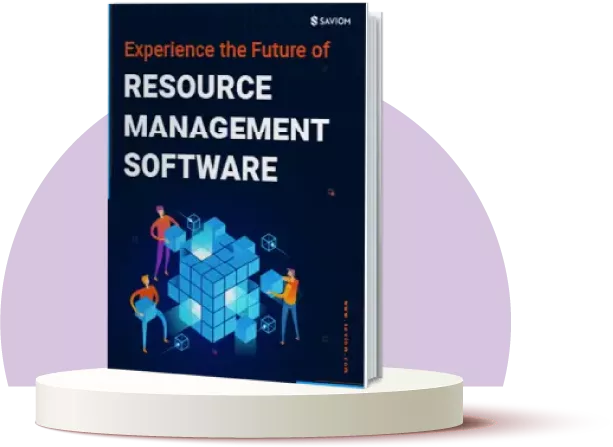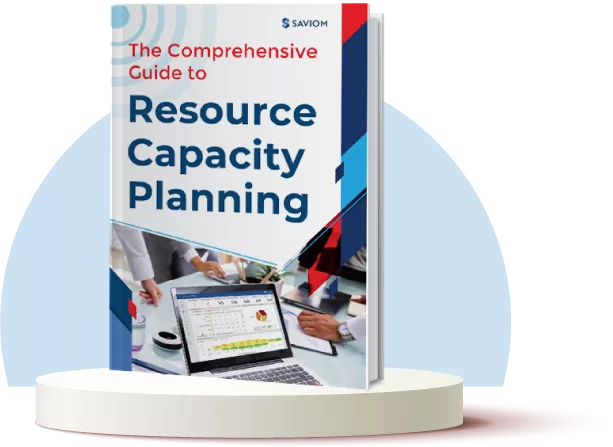“You don’t lack resources. You lack resourcefulness”. ~ Tony Robbins, American author, coach and motivational speaker.
This quote holds a fundamental message that success does not depend on the resources available but on how effectively they are utilized.
In a dynamic business environment, firms and individuals frequently encounter resource constraints in terms of people, time, budget, or information. While these limitations are inevitable and can pose significant challenges, the real problem, however, is not the absence of resources but a lack of resourcefulness.
Resourcefulness is the ability to overcome obstacles by maximizing the full potential of the available resources. It allows firms to devise swift and smart solutions under pressure and effectively navigate unexpected setbacks or changing circumstances. This helps businesses minimize workflow disruptions, seize new opportunities, and stay competitive.
In this blog, we will dive deep into the definition of resourcefulness, key resourceful skills, their importance, and how to develop them in your firm.
Let’s begin.
What is Resourcefulness?
Resourcefulness is the ability to solve problems and navigate challenges by making the most of available resources such as people, tools, equipment, and finances. It combines creativity, adaptability, and forward thinking to find practical solutions, especially when facing limitations or uncertainty. Resourcefulness helps organizations to optimize their talent pool, safeguard their profit margins, and scale their business.
Let us understand resourcefulness better with a real-world example.
Real-world Resourcefulness Example
Consider this instance: A construction company was about to begin building a full residential colony. Based on the plan, the project needed:
- 3 site engineers to manage different work zones
- Several supervisors who oversee day-to-day site activity
- Skilled and unskilled laborers for execution
- Internal coordination with architects and procurement teams
Just before the project launch, two site engineers fell sick, leaving only one available. Hiring replacements would add unforeseen costs and delay approvals.
Here’s how the project manager responded resourcefully without increasing expenses. They:
- Temporarily reassigned two experienced site supervisors to support basic engineering coordination under the guidance of the available engineer.
- Adjusted the project schedule slightly to give priority to tasks that required less engineering oversight in the early stages.
- Used digital tools the company already had to streamline reporting, reducing the on-ground workload for the engineer.
- Involved the architect and procurement teams more actively in site-related planning to reduce pressure on the technical side.
This approach kept things moving, optimized the team’s workload, and reduced extra spending, showing how resourcefulness is about smart, sustainable planning, not just expensive quick fixes.
Read More: Mastering Project Resource Management: A Comprehensive Guide
Let us now see the various resourceful skills required for a firm.
Key Resourceful Skills Every Team Should Have
Listed below are a few critical skills that help individuals be resourceful in an organization –
Adaptability & Flexibility
Adaptability is one of the core skills that demonstrate resourcefulness. It reflects a person’s ability to respond constructively to shifting demands, regulatory changes, or unforeseen resource risks without losing focus, thereby maintaining operational continuity.
Patience
During situations of change, uncertainty, or chaos, patience helps employees to stay calm and composed. It provides the mental space needed to manage ambiguity and stress effectively. By staying grounded under pressure, individuals can think clearly and assess the situation carefully to make sensible decisions for long-term success.
Openness
When faced with unexpected challenges, openness reflects an individual’s willingness to consider new ideas and approaches. It shows a mindset that values diverse perspectives, welcomes constructive feedback, and willingness to learn. These capabilities enable firms to make informed, forward-thinking decisions.
Coordination & Collaboration
A key skill that enables individuals to work collectively as a team to achieve shared goals in a firm. While coordination helps streamline resource-centric workflows across the organization, collaboration sparks the exchange of ideas, building on each other’s insights to ensure well-rounded deliverables.
Creativity
Creativity is a vital resourceful skill that allows people to approach problems or make decisions through innovative, out-of-the-box thinking. Beyond solving issues, it’s about approaching tasks with originality, questioning set assumptions, and applying fresh perspectives to strengthen the firm’s competitive advantage.
Proactive Mindset & Initiative
Here, a proactive mindset reflects the ability to foresee challenges or opportunities and take initiative without waiting for instructions. This highlights the employees’ willingness to step up, address issues, and offer solutions that drive measurable organizational impact.
Persistence & Resilience
Persistence signifies the determination to stay focused and committed despite setbacks or prolonged challenges. Resilience, on the other hand, displays the emotional strength needed to recover from these adverse situations. Together, these skills allow people to deliver consistent output and service quality.
Read More: Top 24 People Skills Every Professional Needs to be Successful
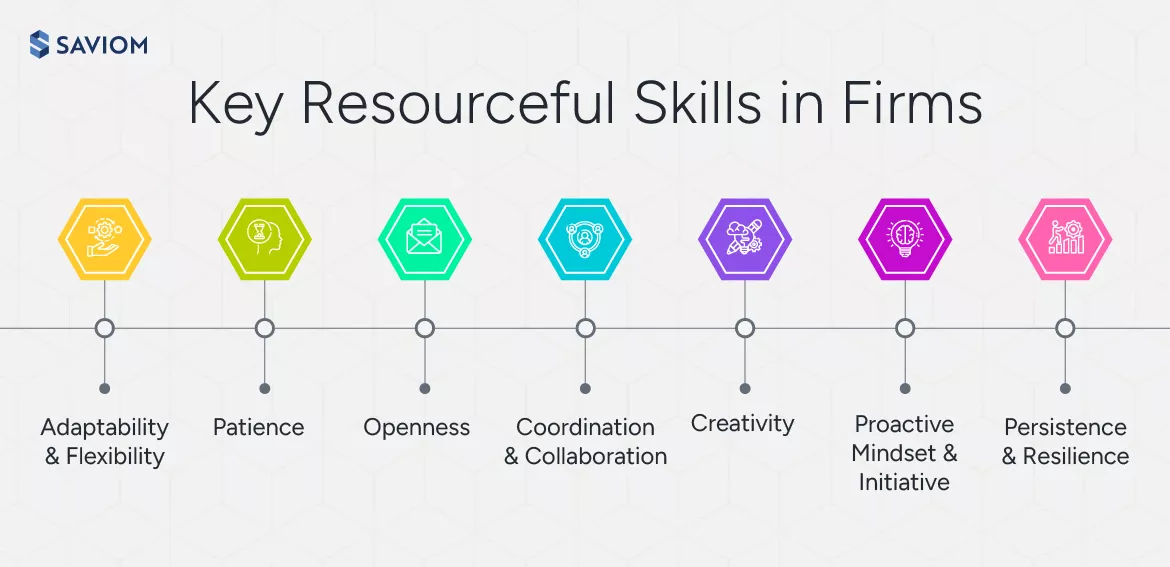
Next, we will see the differences between being resourceful and well-resourced.
Resourcefulness vs. Well-Resourced
Being well-resourced generally refers to firms that have sufficient access to tangible assets like employees, tools, technology, finances, etc. Firms with ample resources are perceived as having a competitive advantage in the market since they have ample capacity to achieve their goals efficiently. However, if firms lack strategic thinking and the ability to utilize their resources to the fullest, even having abundant resources can turn into a bane.
On the other hand, resourcefulness enables businesses to navigate limitations by developing creative ways during unexpected setbacks. It focuses on flexibility, problem-solving, and resilience to reduce the impact of resource constraints on the firm. As a result, a resourceful business is able to streamline processes, overcome obstacles, and drive operational efficiency without conventional means.
In the next section, we shall understand the benefits of resourcefulness in a company.
Importance of Resourcefulness in a Firm
Resourcefulness is a very important skill to have in a company for the following reasons –
Helps with Cost Efficiency
Resourcefulness enables firms to assess and identify cost-effective resources for projects or activities. Instead of relying on last-minute costly hiring, resourceful managers utilize available resources to address urgent demands. They also go a step further to create a judicious mix of senior/junior, local/global, and permanent/contingent workforce to keep costs low without compromising quality.
Read More: What is Resource Planning, and Why is it Important in Project Management?
Streamlines Resource-Centric Workflows
Resourcefulness helps simplify workflows by matching the right people to the right tasks at the right time. It reduces last-minute resourcing chaos and makes planning more predictable and easier to manage. Further, by tracking resource capacity, demand, availability, and utilization, firms can stay proactive and mitigate risks ahead of time. This ensures work moves smoothly and drives timely, successful delivery.
Drives Problem-Solving & Innovation
When a firm is resourceful, the rate of identifying and solving problems before they escalate using smart ideas is much higher. Resourceful people tend to think ahead, stay flexible, and find alternative solutions when standard tools or methods are unavailable. They don’t wait for ideal conditions and turn obstacles into opportunities to drive change and stay ahead of the curve.
Increases Employee Engagement & Morale
Resourcefulness focuses on giving people the freedom and autonomy to think, act, and solve problems using their available means. It builds confidence, keeps work interesting, and makes employees feel trusted, valued, and accountable. Consequently, this creates a deeper sense of purpose, leading to better employee engagement and higher morale.
Read More: Signs of Low Employee Morale and How to Course Correct
Enhances Agility & Competitiveness
The biggest advantage of cultivating a resourceful team is that it enables companies to respond fast to changing priorities, client demands, or unexpected risks. They are able to leverage the available tools, skills, and knowledge at their disposal to stay agile, productive, and competitive. This eventually leads to faster decision-making and an enhanced ability to seize new opportunities & stay competitive.
Enables Sustainable Use of Resources
Resourcefulness always brings in fresh thinking, which helps cut down on unnecessary resource waste. It’s not about having more resources but about using what you already have in the smartest way possible. Instead of overloading teams or letting skills go underutilized, firms can engage in optimal resource utilization, maintaining a balanced health index that drives profitability and project success.
Next, let us move on to the best ways to develop resourcefulness in your firm.
How to Develop Resourcefulness in Your Firm?
Resourcefulness helps your firm adapt quickly and solve problems efficiently. Here are a few ways to build it –
Embed Resourcefulness into Company Culture
Developing resourcefulness starts by making it part of everyday thinking. For that, managers must encourage employees to solve problems on their own, reward creative ideas, and build resilience to navigate setbacks. Thus, when people feel trusted and supported, they take more initiative. It shifts the focus from needing more to doing more with what’s already there.
For example, imagine a marketing team with a tight budget needing visuals for a campaign. Instead of hiring an external designer, one team member with expertise in graphic design uses a free design tool to create quality graphics in-house. The campaign launches on time, saves money, and the team learns they can handle similar tasks without extra resources next time.
Maintain an Up-to-Date Competency Matrix
Managers must regularly track and update the competency matrix to gain comprehensive visibility into the available skills, expertise, qualifications, etc. This insight allows managers to get a sense of their in-house talent, enabling them to utilize and empower the right resources to swiftly respond to current and future project demands.
For example, a software company is launching a new mobile app. As the project began, two developers from the development team were unavailable to continue working due to their existing commitments. Now, since the app has to be launched on the set date, the manager quickly identifies other team members with the right skills and reassigns them to keep the project on track and avoid delays.
Read More: What is Skill Matrix, and Why is it Important for Business Success?
Empower Teams to Assess Their Strengths and Weaknesses
When teams try to evaluate their own strengths and weaknesses, they gain clarity on where they can contribute best and where they need support. This self-awareness empowers them to carefully navigate the challenges at hand with the tools or guidance they already have. Over time, this nurtures a resourceful mindset that helps drive real, tangible results for the organization.
For example, if a team member knows they’re great at data analysis but not confident in client communication, they can focus on delivering strong backend support while collaborating with someone more client-facing. This kind of self-awareness creates a resourceful team that plays to its strengths while filling gaps through smart collaboration.
Recognize and Utilize Pockets of Excellence
Within every team, individuals bring unique strengths, niche skills, or experience in solving specific challenges. By identifying and tapping into these “pockets of excellence,” organizations can elevate overall performance. Those who excel can share best practices or mentor others who may require a helping hand. This not only helps save time but improves overall workforce efficiency across the board.
For instance, a cosmetic company is launching a new product and needs influencers to promote it. Since this requirement was last-minute, no influencer was available at that budget. However, the manager acted quickly in this instance and decided to feature the employees trying the product; the video rose in popularity due to its authentic and relatable content.
Read More: What is Staff Deployment: Definition, Importance, and Key Strategies
Create a Balanced Mix of Resources
Resourcefulness thrives in teams that have a healthy mix of people with varying experience levels, locations, and skill sets. When firms bring together senior/ junior, local/global, or permanent/contingent talent, it creates a space where collaboration and knowledge sharing flourish. This diversity encourages smarter thinking and faster learning to get things done with whatever is available.
For instance, during a website revamp project, a senior UX designer mentors a junior team member on layouts while a freelance content writer refreshes the existing copy. This smart collaboration amongst a diverse resource mix allows the team to meet client expectations quickly without relying on additional external help or requiring extra hands.
Breakdown Silos & Enhance Collaboration
Resourcefulness thrives when individuals move beyond working in isolation and start sharing their knowledge and expertise. When teams talk and communicate openly, they can spot duplicated efforts, streamline repetitive tasks, and make room for innovation. Collaboration also helps reveal & mitigate bottlenecks early and keep projects on track.
For example, in a construction firm, the site team might discover a quicker way to handle material deliveries. If that insight stays just within their project, the benefit is limited. However, when they share it with the planning or procurement teams, it can speed up timelines across several projects. It’s small things like this, such as sharing what works, that make the whole operation run smarter and more efficiently.
Read More: 10 Ways to Improve Cross-Departmental Collaboration
Create a Safe Environment for Risk-Taking
Resourcefulness is all about thinking out of the box and bringing in innovative ideas. To develop that skill, employers must create a space where resources feel safe to take risks and experiment. Further, they must ensure that every idea is welcomed, and smaller failures are seen as learning opportunities. When employees don’t feel judged, they are more likely to innovate and help businesses stay competitive.
Imagine a marketing firm targeting 1 million visitors on their website. One team member suggests an untested influencer campaign instead of traditional ads. Here, the leadership’s willingness to support this calculated risk motivates others to think of bold ideas, too. Even if the campaign doesn’t go as planned, the team learns fast, adapts, tries again, and grows resourceful in the process.
Leverage Technology to Streamline Operations
Using the right tools, such as modern resource management software, makes it easier for teams to work smarter and more efficiently. It empowers firms to significantly reduce repetitive manual tasks, streamline key business functions, and deliver profitable outcomes. Moreover, it enables organizations to scale their operations smoothly, respond to market changes, and improve client satisfaction.
For instance, in an audit firm, leveraging specialized software to automate data collection from multiple financial systems helps reduce tedious manual entries and errors. Auditors get instant access to up-to-date financial records, making it easier to spot inconsistencies or risks early on and take necessary resourcing measures to mitigate them.
Read More: 8 Resource Management Reports for Effective Decision-Making
Foster a Culture of Continuous Learning
Organizations must foster resourcefulness by encouraging people to stay sharp, curious, and open to learning. When teams engage in skill development through regular training, mentorship programs, or certification courses, they begin to approach challenges from different angles. This nurtures a proactive “figure-it-out” mindset that helps them solve problems independently and contribute to organizational goals.
For example, in a mid-sized IT firm, junior developers initially struggled to optimize code performance. However, after an internal workshop, they were able to reduce their system load time by 30%, and they also began to spot inefficiencies on their own. These results highlight how structured training enabled them to take initiative and deliver measurable results.
Let us now see how resource management software can help in building resourcefulness.
How Does a 5th Gen Modern Software Help Develop Resourcefulness?
Advanced resource management software can help collaborate with teams and build resourcefulness. Here is how:
- The tool’s all-in-one resource planner offers comprehensive visibility into employees’ expertise, experience, and availability across the enterprise, enabling managers to make quick, resourceful decisions with available resources.
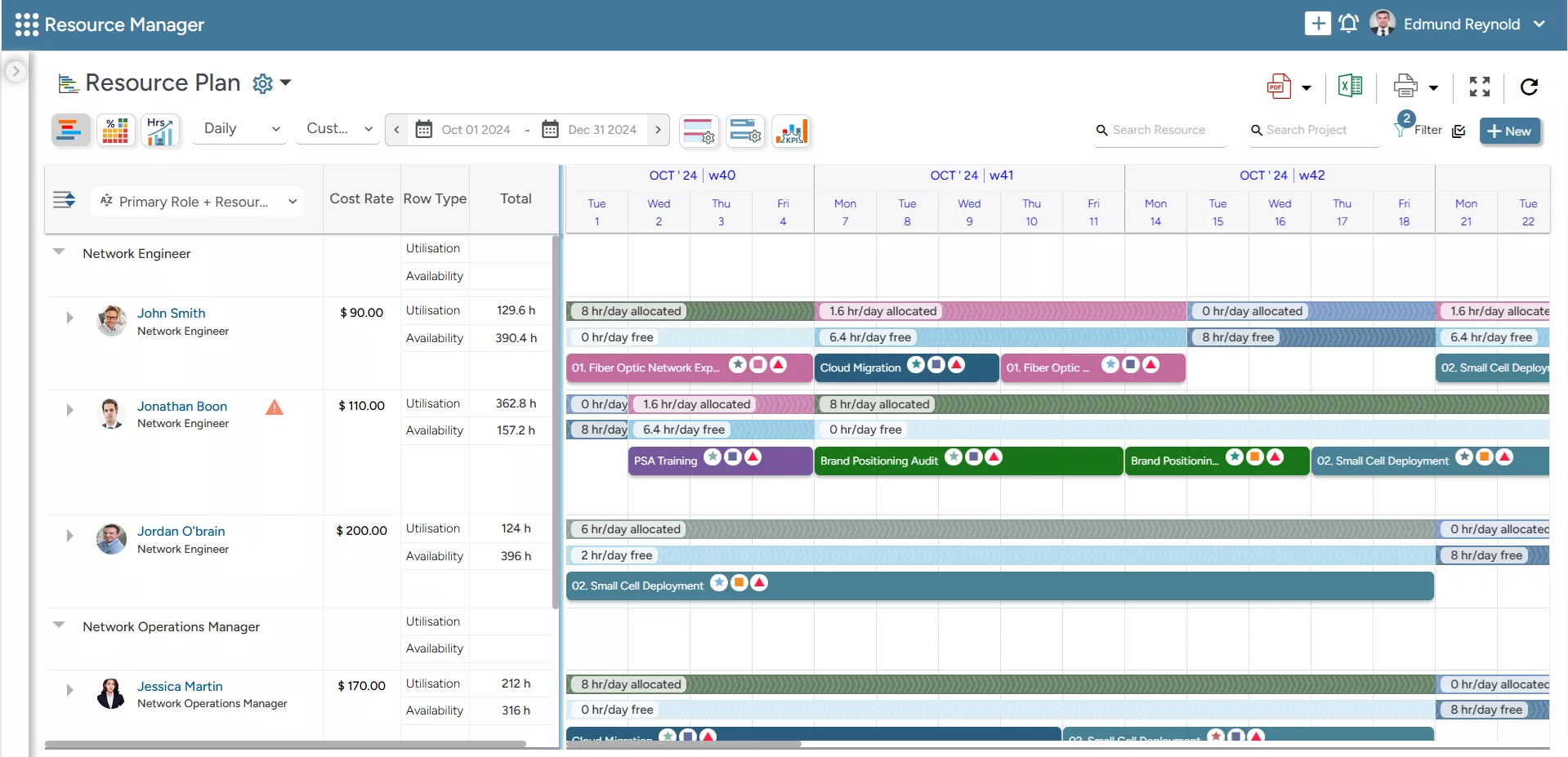
SAVIOM’s All-in-One Resource Planner offers comprehensive visibility into current and future resource schedules for effective implementation of resourcefulness.
- Its embedded capacity planner helps managers predict resource shortage/excess, allowing teams to plan ahead, creatively fill potential shortages, and stay prepared instead of reacting late under pressure.
- Next, the embedded heatmap provides managers with detailed insights into the over-/underutilized resources, where the underutilized resources can be mobilized to meet immediate project demands.
- The KPI forecaster provides insights into key metrics such as skill shortages, under- or overutilization, cost variance, schedule variance, etc., enabling managers to take appropriate actions as deemed relevant.
- The in-built competency matrix helps map employee skills, certifications, qualifications, etc., allowing for transparent talent development and better internal mobility.
- The tool also has real-time BI capabilities that offer reports like bench reports and project vacancies, allowing managers to redeploy available resources to where they’re most needed.
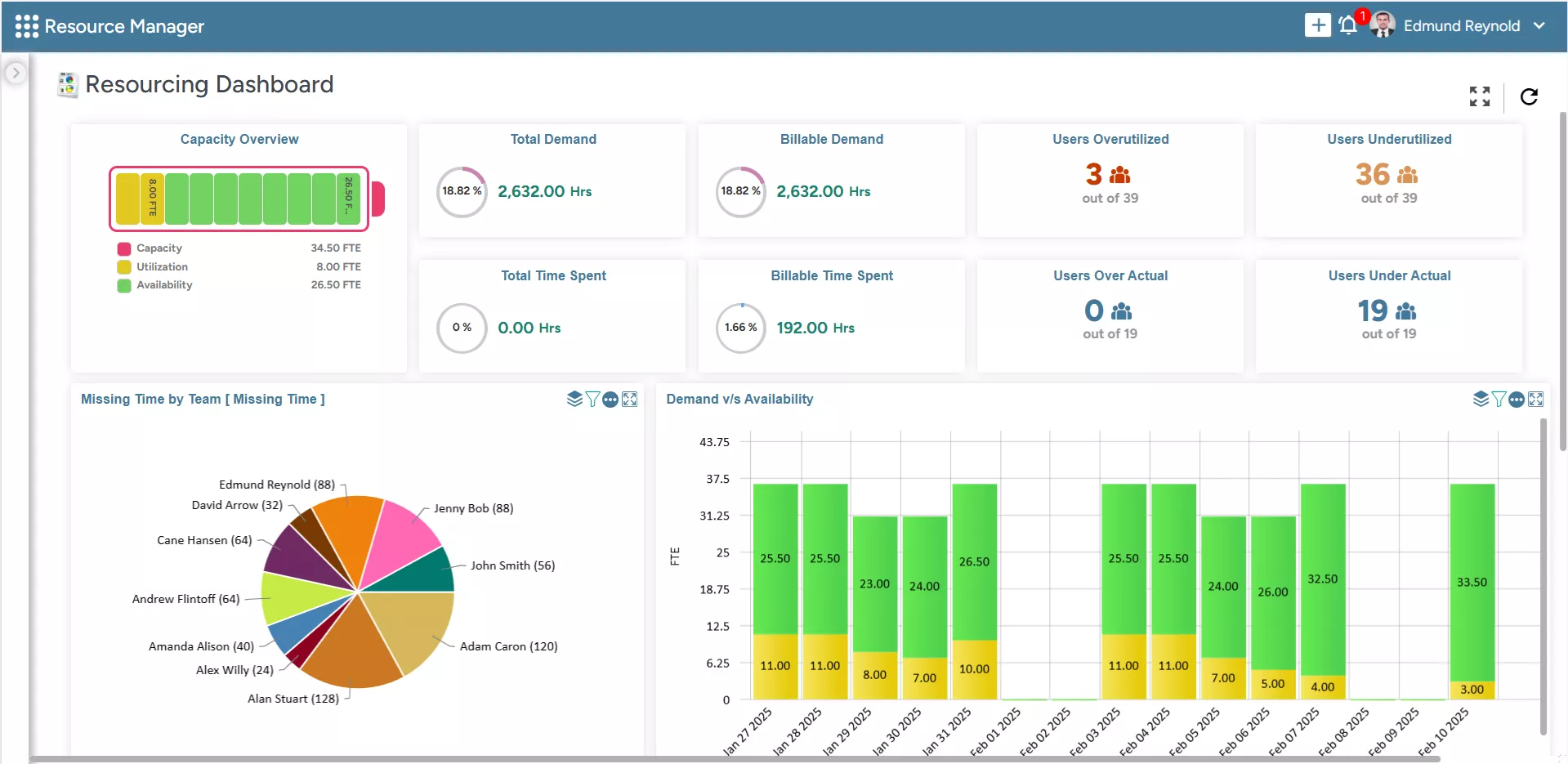
SAVIOM’s Real-time BI Dashboards provide detailed insights into critical resource metrics like capacity, availability, and utilization for informed decision-making.
- The what-if analysis helps create multiple allocation scenarios using available resources, allowing managers to compare options and choose the most cost-effective resource plan.
Read More: How Can You Make Data-Driven Decisions with Resource Management Software?
Conclusion
Resourcefulness, as we now know, is not just any skill, but it is one of the mandatory skills every team should try to cultivate. When individuals become resourceful, they maximize their own capabilities and contribute more effectively. This, in turn, drives strategic, sustainable growth and enhances ROI. Ultimately, success depends not on the quantity of resources but on how well the available resources are utilized.
So, is your team making the most of what they’ve got?
The Glossary
Read More: Glossary of Resource Workforce Planning, Scheduling and Management


